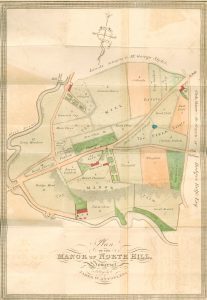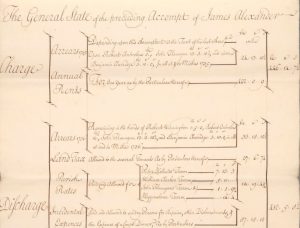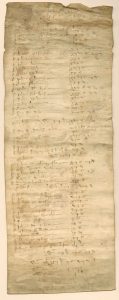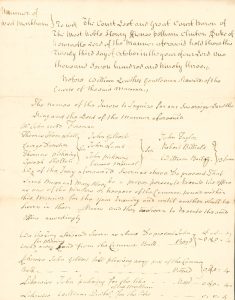July 26, 2022, by Kathryn Steenson
Meet the Manorial Records!
The University of Nottingham is hosting the Manorial Document Register Conference in September, along with The National Archives, and this is the perfect opportunity to talk about one of the most useful collections that researchers find most intimidating: manorial records.
Mind your Manors

Court Rolls and Volumes from the Manor of North Wheatley, Nottinghamshire, 1633-1816. Ref: NWM 1/6-8
What does the word ‘manor’ conjure up in your imagination? Grand country homes? Perhaps with Lord riding around on horseback? Well, that’s not completely inaccurate, but the less romanticised definition is that a manor is an administrative unit of a landed estate of any size. It could vary from a few acres within a parish, to many square miles covering several parishes. In many cases, the manor boundaries correlated with the boundaries of a village but sometimes a single village may have been part of several manors; in other cases a manor may have been a group of scattered lands and farmsteads interspersed with the lands of other manors.
The important aspect was the administration, not the geography. Tenants paid rent and owed service to the lord of the manor, they had to abide by the customs of the manor, and the succession of their land was governed by the manor court, which often also acted as the local court of law for routine offences. Manors were an important feature of local communities.
All Manor of Records
Manorial records survive from the 12th to 20th centuries. They have survived reasonably well compared to other types of record because there was no central registration of land ownership, and manorial records were essential proof of the title to property. Manorial records are notable for being one of the few types of document where information about ordinary people – not just the upper classes – is likely to have survived, perhaps even from the medieval period, with considerable insight into their day-to-day life.
Maps

Map of the manor of North Hill, Somerset, from ‘The elements of land surveying’; c.1817. Ref: LT210.TA/C7
Maps are possibly the most accessible manorial document, and also the rarest. From the 16th century, some manorial lords and ladies employed surveyors and cartographers to make maps of their lands, showing the boundaries of the manor, and topographical features and different types of land. Earlier maps can look slightly amateurish to modern eyes: the perspective and scale are off, they’re not very accurate, and there are often areas of white space where land that wasn’t part of the manor was not recorded. On the other hand, they can be wonderfully detailed and decorated. This image here is a map of the manor of North Hill, Somerset, and comes from the from a book ‘The elements of land surveying’, c.1817. It shows the positions of individual gates and different types of trees, but the surveyor has also spent time creating a far more elaborate scale bar and title than was necessary.
Maps were time-consuming and expensive to produce so they were updated via annotations instead of being redone. It’s not unusual to see deceased tenants’ names crossed out and the name of the new inhabitant neatly written alongside.
Rentals and Extents
Rentals are lists of tenants who held land in the manor, along with a description of the land they held and a record of the rent they paid. Rent payments weren’t always money: plenty of tenants paid in livestock or produce. Rentals weren’t made as frequently as other manorial records or accounts – for example a rental may only have been made when a new lord or lady of the manor was taking over – and as a result, they do not survive in as large numbers.
Extents are similar, in that they also include details of rents, but included much more information. An extent was a description and valuation of all the items on the manor, from the manor house and its gardens and grounds, mills, land (divided into sections for arable, meadow, pasture and woods), and then tenants’ rents and services. Extents were normally earlier in date than rentals. This one here is from 1357 and is for the manor of Bevercotes in Nottinghamshire.
Courts
There were two kinds of manorial court: court baron, and court leet with view of frankpledge.
The court baron was the most important. Held every three or four weeks, it administered the customs of the manor and dealt with any offences against it. It also dealt with various matters affecting the local community, such as enforcement of labour services (every tenant owed labour to the lord of the manor), the administration of justice for minor crimes, and the election of local officials.
The court leet was more concerned with the enforcement of law and order and was normally held every six months. In the absence of any formal police service, this was in the form of a system of collective responsibility known as the view of frankpledge. The court leet would also try offences such as assaults, obstruction of highways, or the breaking of laws regarding the weight of bread and ale sold.
Accounts

Page from estate account and rental for the manor of Dracklow and Rudheath, Cheshire, for the year ending Michaelmas 1736
Accounts were kept by the kept by the manor’s steward or bailiff and record the ‘charge’ (income) and ‘discharge’ (expenditure). Charges might be from rents, the sale of produce or from fines issued in the manorial court. Discharges of monies paid out by the steward included purchasing corn or livestock, repairing buildings or paying for labour. Each account covered a single year, running from Michaelmas (29 September) to Michaelmas.
There are many more types of manorial document, but these are a few of the main ones and give an introduction into the kind of matters that came under their jurisdiction. Over the next couple of months, we’ll be doing a series of social media posts and dedicating an issue of our newsletter Discover to manors and manorial documents, to tie in with the Manorial Documents Register Conference later this year.
The Conference
The conference is jointly hosted by The National Archives and the University of Nottingham. This year marks the centenary of the Law of Property Act that dissolved the manorial system and laid the groundwork for giving the Master of the Rolls jurisdiction over manorial records. The National Archives administers these responsibilities on behalf of the Master of the Rolls. This centenary is an occasion to look back on a century of work protecting and promoting access to manorial records, as well as an opportunity to mark the completion of 30 years of work to computerise the Manorial Documents Register for England and Wales.
No comments yet, fill out a comment to be the first



Leave a Reply